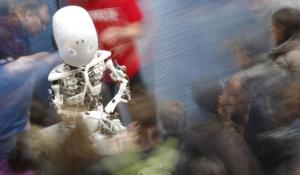Best 25 papers will be published online.Participate in this special issue and get a chance to win the Best Paper Award for Image Processing. Also other authors will have special prizes to be won.
-
Last Date For Paper Submission of Special Issue : 25th August 2015
What is Image Processing?
Image processing is a method to convert an image into digital form and perform some operations on it, in order to get an enhanced image or to extract some useful information from it. It is a type of signal dispensation in which input is image, like video frame or photograph and output may be image or characteristics associated with that image. Usually
Image Processingsystem includes treating images as two dimensional signals while applying already set signal processing methods to them.
It is among rapidly growing technologies today, with its applications in various aspects of a business. Image Processing forms core research area within engineering and computer science disciplines too.Image processing usually refers to digital image processing, but optical and analog image processing also are possible.
Analog or visual techniques of image processing can be used for the hard copies like printouts and photographs. Image analysts use various fundamentals of interpretation while using these visual techniques. The image processing is not just confined to area that has to be studied but on knowledge of analyst. Association is another important tool in image processing through visual techniques. So analysts apply a combination of personal knowledge and collateral data to image processing.
Digital Processing techniques help in manipulation of the digital images by using computers. As raw data from imaging sensors from satellite platform contains deficiencies. To get over such flaws and to get originality of information, it has to undergo various phases of processing. The three general phases that all types of data have to undergo while using digital technique are Pre- processing, enhancement and display, information extraction.
If you have worked on any part of image processing
prepare a research paper and submit to us
Image processing basically includes the following three steps.
- Importing the image with optical scanner or by digital photography.The acquisition of images (producing the input image in the first place) is referred to as imaging.
- Analyzing and manipulating the image which includes data compression and image enhancement and spotting patterns that are not to human eyes like satellite photographs.
- Output is the last stage in which result can be altered image or report that is based on image analysis.
Purpose of Image processing
The purpose of image processing is divided into various groups. They are:
- Visualization - Observe the objects that are not visible.
- Image sharpening and restoration - To create a better image.
- Image retrieval - Seek for the image of interest.
- Measurement of pattern – Measures various objects in an image.
- Image Recognition – Distinguish the objects in an image.
Applications of Image processing
Image processing has been an important stream of Research for various fields. Some of the application areas of Image processing are….
Intelligent Transportation Systems – E.g. Automatic Number Plate Recognition, Traffic Sign Recognition
Remote Sensing –E.g.Imaging of earth surfaces using multi Spectral Scanners/Cameras, Techniques to interpret captured images etc.
Object Tracking – E.g. Automated Guided Vehicles, Motion based Tracking, Object Recognition
Defense surveillance – E.g. Analysis of Spatial Images, Object Distribution Pattern Analysis of Various wings of defense. Earth Imaging using UAV etc.
Biomedical Imaging & Analysis – E.g. Various Imaging using X- ray, Ultrasound, computer aided tomography (CT) etc. Disease Prediction using acquired images, Digital mammograms.etc.
Automatic Visual Inspection System – E.g.Automatic inspection of incandescent lamp filaments, Automatic surface inspection systems, Faulty component identification etc.
And many other applications…..



